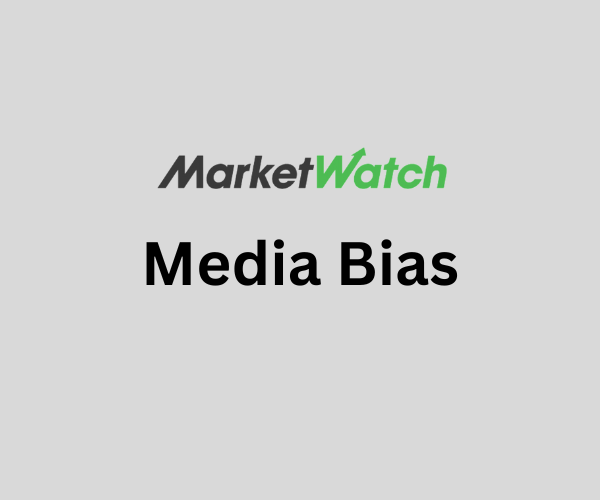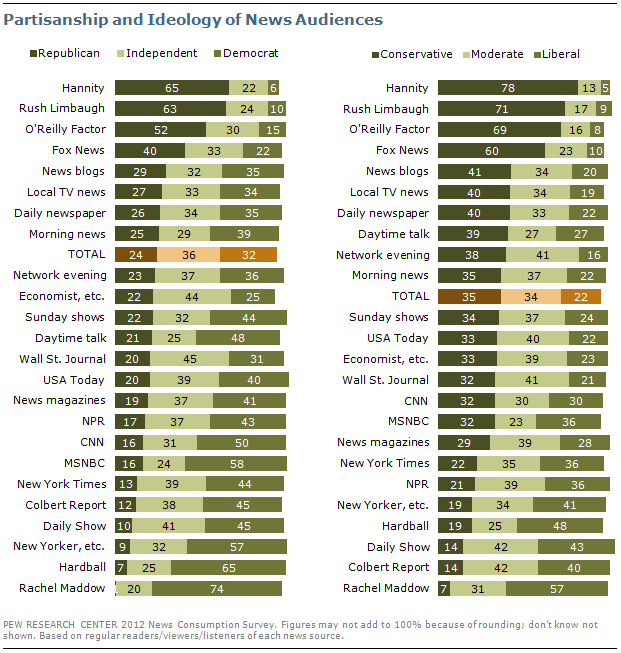
MarketWatch, established in 1995 by Larry Kramer and Thom Calandra and later acquired by Dow Jones & Company, is a media outlet dedicated to business, finance, and stock market news. It is similar to, but smaller than, other popular economic outlets, possessing just over half of the monthly page visits of Forbes and around ten million less than the Wall Street Journal.
While MarketWatch may not have enough data on the political ideology of its viewership, we do know that the majority of its viewers live in the U.S., are male, and are between 25 and 55 years of age. These demographics are very similar to those of WSJ and Forbes. Thus, we can infer the readership, and their political ideologies, are similar.
Studies from the Pew Research Center have revealed that readers of the Wall Street Journal are mostly centrist (41%) and conservative (32%), with a handful of liberal viewers (21%).

Source: Pew Research Center
But, as viewership is not an accurate indicator of a news outlet’s political bias, we will examine MarketWatch in more detail in the rest of this article. As MarketWatch is a potential contender with the popular Wall Street Journal, it is important to consider bias in their reporting and to discuss how to detect and identify types of bias in the news in general.
How Does Biasly Rate News Sources?
Biasly’s algorithms produce bias ratings to help provide multiple perspectives on given articles. Biasly has analyzed 200,000+ news articles from more than 3,200 news sources through our A.I. technology and team of political analysts to find the most factual, unbiased news stories.
Biasly determines the degree of political bias in news sources by using Biasly’s Bias Meter Rating, in which Biasly’s team analyzes media sources’ reliability and bias and produces three scores, a Reliability Score that measures the accuracy of media sources; an A.I. Bias Score, evaluated by A.I.; and an Analyst Bias Score evaluated by political analysts. These scores are rated based on seven rating metrics including Tone, Tendency, Diction, Author Check, Selection/Omission, Expediency Bias, and Accuracy. These metrics help our analysts to determine the political attitude of the article.
Our A.I. machine-learning system employs natural language processing and entity-specific sentiment analysis to examine individual articles and determine their bias levels. By analyzing the key terms in an article such as policies, bias phrases, political terminologies, politicians, and their nicknames, the algorithms can rate the attitude of the text. Bias scores range from -100% and 100%, with higher negative scores being more liberal and higher positive scores being more conservative, and 0% being neutral.
Is MarketWatch Media Politically Biased?
MarketWatch has been criticized for political bias, as well as lack of accurate reporting. Numerous critical reviews have been posted on various sites such as SiteJabber and Trustpilot.
Abraham C., for instance, says that:
“I’ve used [MarketWatch for a while] now and have noticed a politically fueled news feed. In their community guidelines for comments they praise being an open platform but all comments go through [an editor] who rejects all dissenting views. Shame on them.”
In this case, he references several liberal-leaning comments he left on vaccine mandates. However, Richard O. claims that MarketWatch is liberally biased, saying:
“I used to enjoy MarketWatch as a good financial news source. Now I find most articles relate to some political issue commending the ‘progressive’ value or nullifying the conservative viewpoint.”
So is MarketWatch liberal, conservative, or centrist? In the following sections, we will analyze different articles and clips to determine whether MarketWatch has bias, and how much bias it has. But first, let’s take a look at Biasly’s media outlet ratings.
Biasly provides both A.I. generated and analyst-reported political bias scores for media outlets, articles, and politicians alike. In the case of MarketWatch, it scored an A.I. generated Bias Meter rating of Centrist and an analyst score of Centrist as well.
Biasly’s analyst-reported scores are made by teams of three (one conservative, one moderate, and one liberal) analysts going through at least 15 articles from each news source, while its A.I. scores are generated through an analysis of positive or negative outlooks towards political figures, policies, and bias words and views on popular political hot topics such as abortion or gun control.
Our bias ratings, both computer-generated and analyst-reported, are typically very similar to those of other third-party agencies.
But before we begin, we need to discuss bias. Bias is a natural function of humans, and we can express it both consciously and unconsciously. Bias is one of the most fundamental forms of pattern recognition in humans. This isn’t to lower the bar and say that “all things are biased,” but to explain the process in which we may come to trust certain news organizations that display patterns of coverage.
On the media’s part, there is an incentive to retain audiences, encourage them to purchase subscriptions, and rate products positively. Bias is a two-way street, people want to see news stories about things they care about, and the media needs viewers to continue their operations. This creates a positive feedback loop that influences what stories are covered and from what perspective. This also explains the actions of more liberal news organizations.
Analysis of Bias in MarketWatch Media Online Articles
When analyzing articles for bias, we must take stock of three things. First, we need to pay attention to the author’s tone, or attitude, towards certain subjects or people. Secondly, we need to examine diction or word choice. Lastly, we look at who the author is, their views on political subjects, their past articles, etc.
For instance, the article “China Tightens Controls on Graphite. The Hunt Is On for New Supplies.” is rated Center by Biasly. In the article, the author maintains a neutral tone, summarizing the facts and using a very large number of statistics to back them up, such as in
“The U.S., on the other hand, doesn’t mine or produce any natural graphite. From 2018 to 2021, about 33% of U.S. imports came from China, followed by 18% and 17% from Mexico and Canada, respectively.
American companies have been looking to cut their dependence on China. Africa has been a hot spot for graphite exploration. Mozambique and Madagascar are the second and third largest miners of natural graphite behind China, with 170,000 tons and 110,000 tons of production in 2022, respectively.”
Note, how the author does not say what she thinks American companies should do, but rather what they are currently doing, without discussing her opinion on their actions either. In addition, she also utilizes unbiased diction. Typically, we would also analyze her social media posts for information on her political stance, but her Twitter account only shows one post, which she used to share one of her articles published in Barron’s.
Most articles from MarketWatch are similarly unbiased, with those that are only mildly biased. For instance, “U.S. and Arab partners disagree on the need for a cease-fire as Israeli airstrikes kill more civilians” displays a slight liberal bias, but is still close enough to centrist to fall into the Centrist category.
The author, for instance, maintains a negative tone when discussing Israel, while speaking positively about the Palestinians. Because Republicans largely support Israel, while Democrats are more supportive of the Palestinians, this can be considered a liberal stance, contributing to the slight liberal bias of the article.
Consider these paragraphs from the article:
“Israel has repeatedly demanded that northern Gaza’s 1.1 million residents flee south, and on Saturday it offered a three-hour window for residents to do so. An AP journalist on the road, however, saw nobody coming. The head of the government media office in Gaza, Salama Maarouf, said no one went south because the Israeli military had damaged the road.
But Israel asserted that Hamas ‘exploited’ the window to move south and attack its forces. There was no immediate Hamas comment on that claim, which was impossible to verify. Some Palestinians said they didn’t flee because they feared Israeli bombardment.
‘We don’t trust them,’ said Mohamed Abed, who sheltered with his wife and children on the grounds of Shifa hospital, one of thousands of Palestinians seeking safety at medical centers in the north.”
By stating that the Israeli statement that Hamas had exploited their offering of evacuation for Gaza’s civilians was impossible to verify, the authors paint Israel as unreliable and perhaps deceitful, a sentiment which was furthered by the quote from refugee Mohamed Abed and their usage of negative diction (using “demanded” to describe Israel’s request that Gaza’s residents evacuate). In addition, the author mainly focuses on the Palestinian death toll, sparing only a few sentences and the last paragraph for the Israeli death toll.
If we examine the authors’ Twitter accounts, we see a similar liberal bias. Although Najib Jobain’s Twitter says little and Cara Anna doesn’t have an account, Bassem Mroue is fairly active and provides a good basis for analysis.
Mroue, while mostly only providing facts about the crisis in Gaza, occasionally expresses his opinions on the matter. For instance, on October 29th, he tweeted:
“#Israel says its war can both destroy #Hamas and rescue hostages. Their families are less certain @FrankelJulia (from @AP)”
#Israel says its war can both destroy #Hamas and rescue hostages. Their families are less certain @FrankelJulia (from @AP) https://t.co/20SSDH6nmt
— Bassem Mroue باسم مروه (@bmroue) October 29, 2023
By stating Israel’s beliefs, then following them up with the opposing beliefs of others, Mroue casts doubt on Israel’s ability to both wage war and minimize civilian casualties and hostages. It must be noted, however, that this tweet is still more on the centrist end than the liberal end, as Mroue does not explicitly state his opinion on the situation, unlike other, more biased articles from other media sources such as New York Times’ (which has a Biasly bias meter rating of Moderately Liberal) article Israel Is About to Make a Terrible Mistake, an article discussing Israel’s continual waging of war against Hamas.
Analysis of MarketWatch Opinion Articles
Opinion articles, or op-eds, as they are sometimes known, are different from traditional articles in that they do not prioritize informing the public, but rather, stating and arguing an opinion. Thus, they may be more biased than traditional articles, but that does not mean that they do not strive for factuality and can in many cases be accurate sources of information.
Consider the op-ed The ‘Musk double standard’: Why rebel men are lionized but women get criticized. This title is moderately liberal-leaning, given the fact that conservatives largely believe that gender equality has been achieved (72% of conservatives surveyed by Pew Research Center said it either has been achieved or has gone too far), whereas 69% of liberals believe that it has not gone far enough.
Amazon kicks more plastic packaging to the curb in favor of a new paper, on the other hand, holds a relatively neutral title. While conservatives are usually less likely to support clean energy than Democrats (although of course this varies from person to person and a majority of conservatives do support it), and so “[kicking] plastic packaging to the curb” could be interpreted as favoring plastic packaging and mourning its loss, the language is ambiguous and could also be interpreted as favoring paper packaging and celebrating the disappearance of plastic packaging. Quotes from the article itself reveal the article to be slightly liberally biased:
“In its first U.S. plastic-free fulfillment center, the retail giant has come up with a lighter, stronger paper packaging that consumers can recycle curbside”
By focusing on the good aspects of paper packaging, using positive words such as “lighter” and “stronger,” the article is revealed to favor paper packaging.
These articles, of course, do not accurately represent all of MarketWatch’s articles and their corresponding biases, but they do help to illustrate how opinion articles are often more politically biased than traditional journalistic reporting.
Who Owns MarketWatch?
MarketWatch is currently owned by Dow Jones & Company, as are the Wall Street Journal and Barron’s. While the Dow Jones itself does not have a direct rating, its sister news outlets have been rated as Somewhat Conservative (WSJ) and Center (Barron’s), respectively. The lack of strong bias in these two outlets aligns with MarketWatch’s centrist perspective, while the conservative bias of the editor-in-chief, Mark DeCambre, matches up with MarketWatch’s 6% conservative bias.

Source: MarketWatch
Editors-in-chief are in charge of creating the look of a publication and deciding what pieces to feature and publish. As such, Mark DeCambre’s conservative beliefs likely had some influence over that of MarketWatch itself.
Given that MarketWatch does not change ownership very frequently, it is already relatively unbiased, and most of its articles are locked behind a paywall, creating a stable source of revenue for the company, it is unlikely its bias or reliability will change in the coming years.
How to Evaluate and Uncover Bias
It can often be difficult to tell if the news you watch is biased. If you have settled on a news channel, it’s usually because you trust the information you are gaining. Unfortunately, many trust the information they are hearing because it confirms what they already believe. This is referred to as “confirmation bias.” It is important to challenge your beliefs and get third-party verification that what you are hearing is the full story. This is why we recommend using Biasly to compare different news stories side-by-side using our bias ratings to figure out what both sides think of a political issue.
Even though MarketWatch has received a rating of Centrist, that does not mean that all of their articles will be unbiased. It is important to note, too, that opinion articles are more often biased than regular articles as opinion articles seek to persuade, not only perform, and personal emotions can often override journalistic neutrality or accuracy. One easy way to check each article for bias prior to reading it is to use Biasly’s News Check browser extension.























